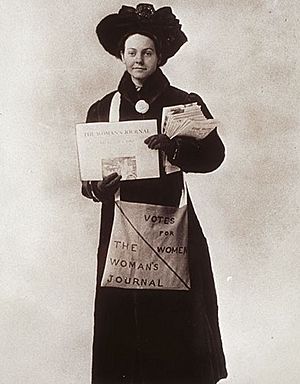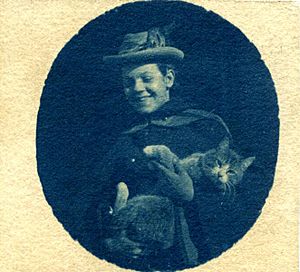Florence Luscomb facts for kids
Quick facts for kids
Florence Luscomb
|
|
|---|---|

Florence Luscomb selling
The Woman's Journal, 1911 |
|
| Born |
Florence Hope Luscomb
February 6, 1887 |
| Died | October 13, 1985 (aged 98) Emerson Convalescent Home in Watertown, Massachusetts, US
|
| Occupation | Architect, activist for woman suffrage |
| Known for | Degrees in architecture 1909, 1910 from MIT |
Florence Hope Luscomb (born February 6, 1887 – died October 13, 1985) was an amazing American architect and a strong activist for women's right to vote in Massachusetts. She was one of the very first women to graduate from the Massachusetts Institute of Technology (MIT) with a degree in architecture. Florence later became a partner in one of the first architecture firms owned by women. When it became hard to find architecture work during World War I, she decided to focus all her energy on helping women get the right to vote. She became a very important leader in the women's suffrage movement in Massachusetts.
Early Life and Family
Florence was born in Lowell, Massachusetts. Her mother, Hannah Skinner Knox, was a dedicated activist for women's rights. Her father, Otis Luscomb, was an artist. When Florence was just one and a half years old, her parents separated. She moved with her mother to Boston, while her older brother lived with their father.
Even as a child in Boston, Florence went with her mother to events about women's right to vote. She even saw the famous Susan B. Anthony speak! Florence quickly became a strong supporter of women's suffrage. She started by selling a newspaper that supported women's voting rights on the street.
Becoming an Architect
Florence Luscomb was one of the first ten women to earn a degree in architecture from the Massachusetts Institute of Technology (MIT). Back then, women faced many challenges in their studies and careers. For example, Florence had to ask twelve different companies before one would hire her for an internship after her second year at MIT.
After she graduated, Florence was hired by Ida Annah Ryan. Ida was also an architect and one of the first women to get an architecture degree from MIT. Later, Florence became a partner in Ida's architecture firm. Both Ida and Florence were interested in women's right to vote. Ida gave Florence the freedom to work on the women's suffrage movement while still doing her architecture job.
During this time, Florence helped organize many events for the suffrage movement. She even gave more than 200 speeches in just 14 weeks! These speeches were part of a public discussion about adding a women's suffrage amendment to the state constitution.
Florence continued her architecture studies in 1916 at the new Cambridge School of Architecture and Landscape Architecture. She also worked with other architects. However, when the United States joined World War I in 1917, new building projects slowed down. This put her architecture career on hold.
A Life of Activism
Because architecture work was slow during World War I, Florence took a job as an executive secretary for the Boston Equal Suffrage Association for Good Government. This marked a new path for her, focusing fully on activism.
She went on to work for many important groups in Boston. These included the Boston chapters of the League of Women Voters and the Women's International League for Peace and Freedom. She also worked with groups that wanted to improve prisons and make factories safer. When women finally gained the right to vote, Florence became a founding member of the League of Women Voters.
Florence also helped start a local branch of the United Office and Professional Workers of America. She volunteered with the local NAACP and the ACLU. From 1911, she saw herself as a "citizen of the world." She traveled to many countries in Europe and Asia for conferences.
After her mother passed away in 1933, Florence inherited enough money to dedicate all her time to activism. She ran for public office four times, not necessarily to win, but to bring attention to the causes she cared about. She almost won her first race for the Boston City Council in 1922. Her later campaigns for Congress and governor were mostly to protest things she felt were unfair. She was a strong opponent of McCarthyism, which was a time when people were unfairly accused of being communists. She also wrote one of the first leaflets against the Vietnam War. Later, she advised leaders of the American feminist movement, encouraging them to include poor women and women of color in their efforts.
Florence designed her own vacation cabin in Tamworth, New Hampshire. After World War II and until the 1970s, she spent her summers there. She also helped the Appalachian Mountain Club.
Florence lived in different cooperative houses after her mother's death. She lived in a Cambridge cooperative house until 1980. Then, she moved to an elder-care facility in Watertown, Massachusetts. She passed away there on October 13, 1985, at the age of 98.
Remembering Florence
In 1999, a special memorial was added to the Massachusetts State House. It includes six tall marble panels, each with a bronze statue of a famous woman. Florence Luscomb is one of these women. The others are Dorothea Dix, Mary Kenney O'Sullivan, Josephine St. Pierre Ruffin, Sarah Parker Remond, and Lucy Stone.
Two quotes from each of these women are carved into their marble panels. The wall behind the panels has wallpaper with important government documents related to the women's causes. Florence Luscomb is also honored on the Boston Women's Heritage Trail.


